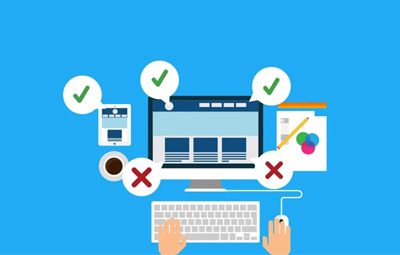When you think about website design, what comes to mind? Do you think about how your website will look on a phone or computer? Or do you worry about the content? There are plenty of other factors to consider when designing a website, but ensuring the site looks good on all devices is one of the most important.
What are website design mistakes?
A website is the face of your business. It's where potential and current customers come to learn about you, what you do, and how you can help them. That's why it's important to ensure your website design is top-notch. But what are some common website design mistakes that businesses make? Read on to find out.
1. Not using a consistent color scheme: Different parts of your website should use different colors so the user can easily differentiate between them. This is especially important if you have a lot of content on your website – users will have trouble finding what they're looking for if everything is mixed together. So, to use the right color scheme, get in touch with the best Chennai web design company.
2. Not using fonts that are easy to read: Headlines, body text, and other important elements should be written in a typeface that is easy to read. If your font needs to be simplified or updated, users will likely give up before they even start browsing your site. To know what fonts you must use, contact the right website designing company.

3. Not providing enough information about your products or services: If people need to know what you offer or how much it costs, they're not going to want anything to do with it (especially if you charge a high price). Make sure all of the information you need right off the bat is included in the primary content area of your website. To optimize the information as per the right SEO metrics, call the best web designing company in Chennai.
4. Not providing enough information about your company or team: People need to know who you are and what you stand for to be interested in what you have to say. Ensure all important information is prominently displayed on your homepage and throughout your website.
5. Not using any graphics or images: Many people think adding graphical elements like photos or icons can improve a site's look, but this is only sometimes the case. A well-designed website should be void of any visual distractions, making it easier for users to navigate and find what they're looking for.
6. Not setting up your content properly: If your site isn't well organized, visitors will have trouble finding what they're looking for and may even leave your site altogether. Make sure you have clear headings and use keyword tags when organizing your content so that readers can find what they need quickly and easily.
7. Poor accessibility. Plugins can often conflict with one another, causing sections of your website to be inaccessible to users with certain disabilities.
8. Increased load times. When numerous plugins are required in order to function correctly, your website will likely suffer from long load times.
9. Inability to update or modify the site. Many plugins require administrative privileges to be updated or modified, which can be difficult if you're not the site administrator.
10. Poor search engine optimization (SEO). If your website relies heavily on outdated or non-functional plugins, it will be harder for Google and other search engines to index it effectively. This could lead to decreased traffic and lost business opportunities
11. Using too many tabs or buttons: One of the biggest mistakes web designer company in Chennai make is using too many tabs or buttons. Tabs and buttons take away from the page's focus and can confuse users. Try to keep your design as simple as possible by using only one or two tabs or buttons.
12. Lack of hierarchy: Another common mistake website designers make is a lack of hierarchy. Hierarchy helps users quickly understand a document's structure and makes navigation easier. Try to use headings and subheadings when possible to create an organized layout.
13. No content summary or introduction: professional web design company in Chennai often need to pay more attention to including a content summary or introduction at the top of their pages. This section provides a brief overview of what's on the page, which can help people decide if they want to stay on the page. Including this section also sets a positive tone for the rest of the site and gives users an idea about what they're getting themselves into before they open it up!

14. Poor conversion rates due to poor design: Poor design can also lead to poor conversion rates. Poor design can make people uncomfortable and confused, leading them to leave your website altogether. Make sure that all of your pages are designed with a focus on user experience, and conversions will follow. So, to create an impactful website, just search for website designers near me, and call us now!
15. Not Paying Attention To 404 Page Design Can Hurt SEO: 404 pages are one of the most common reasons a website may not rank well in search engine results. Not properly designating 404 pages as such can cause people to think your website is inactive, which may not be the case at all. To resolve all 404-page issues, contact the right responsive web design company Chennai now.
16. Use clear calls-to-action: If someone clicks on a link on a 404 page, make sure you have clear instructions as to what they should do next (such as signing up for a newsletter or downloading a brochure). This will help increase conversion rates and give you more data about what content resonates with visitors.
17. Not using SSL or HTTPS: It's no secret that SSL (Secure Sockets Layer) and HTTPS (Hypertext Transfer Protocol over Secure Socket Layer) are two of the most important technologies for protecting your website against unauthorized access. Without SSL or HTTPS, anyone could intercept your traffic and learn sensitive information about your sites, such as its username and password. For more tips on securing your website, check out our guide to making your site secure with SSL and HTTPS. To use an efficient SSL, contact the top designers in Chennai.
18. Not encrypting data: When you transmit data over the internet, you should always encrypt it using a security protocol like AES-256 encryption. This will help protect your data from unauthorized access by hackers. For more information on encrypting your data, check out our guide on encrypting your website traffic.
19. Not keeping track of user activity: You need to keep track of user activity on your website to be able to determine who has accessed your data and who hasn't. This can lead to data theft and other security breaches. To keep track of user activity on your site, use a tracking tool like Google Analytics.
20. Not using placeholder images: If you're uncertain about which photo to use for a certain piece of content, use a placeholder image instead – this way, you can change the image later without having to edit all your text as well (although doing this sparingly is always advised).
21. Creating a cluttered or confusing layout: A cluttered or confusing layout can be very off-putting to website visitors. It can also be difficult for search engines to index your site properly. Make sure your layout is easy to understand and navigate and keep fonts small to avoid overwhelming users with information.
22. Choosing the wrong web browser window size.
When designing a website, it is important to ensure that all windows – including the main and web browser windows – are set to the appropriate size so that they display properly on different devices (PCs, tablets, phones). While most websites look good in any size window, trying different sizes can help you determine which works best for your site on different devices.
23. Failing to research web standards: Unless you have a specific reason for not following web standards, always make sure your website uses a standard font, width, and height across all devices. This will make it easier for users to navigate, and search engines will better understand your content.
Conclusion
It's time to face the facts: website design mistakes are being made. Whether it's failing to research your niche properly or not tailoring your site to your target audience, there are ways in which you can make sure your site is on-brand and looks great on every device. In this article, we'll look at some of the most common website design mistakes and advise how to avoid them. So what are you waiting for? Start fixing those pesky design flaws today!



